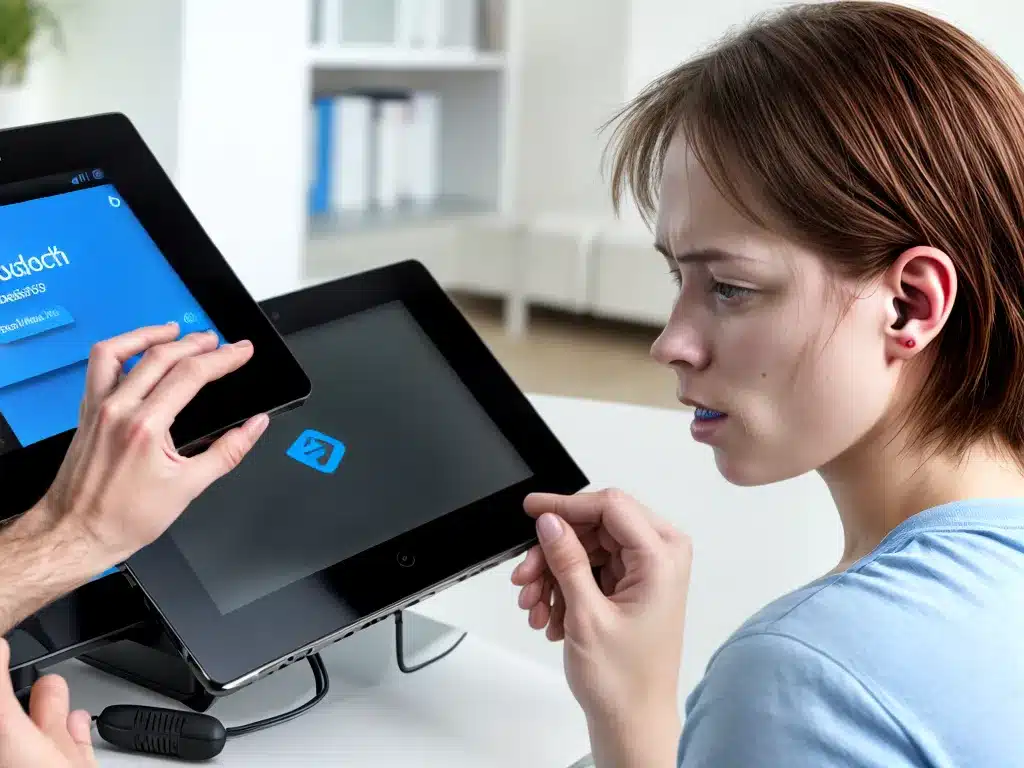Bluetooth technology allows devices to wirelessly connect and communicate with each other. However, sometimes you may encounter connection issues that prevent your devices from pairing or communicating properly. Here are some tips for troubleshooting common Bluetooth problems.
Finding the Source of the Issue
When two Bluetooth devices fail to connect or encounter connectivity problems, the issue can originate from either device. Follow these steps to identify the source of the Bluetooth trouble:
Check the Bluetooth Settings on Both Devices
- Ensure Bluetooth is turned on for both devices. Bluetooth connectivity cannot work if one or both devices have Bluetooth disabled.
- Verify the devices are visible/discoverable to other Bluetooth gadgets. The device may connect only if set to be discoverable.
- Ensure the two devices are within the functional range of Bluetooth, usually up to 10 meters or 33 feet without obstructions. Large distances or objects blocking the signal can prevent pairing.
Update Bluetooth Drivers
Outdated drivers often cause Bluetooth connectivity problems. Updating to the latest drivers may resolve many pairing issues.
- On Windows: Visit the device manufacturer’s website to find the latest drivers for the Bluetooth adapter. Install these updated drivers.
- On Mac: Click the Apple menu and select System Preferences > Software Update to update macOS and Bluetooth drivers.
- On Android: Open Settings > System > Advanced > System Update to update Android and installed Bluetooth drivers.
Reset Network Settings
Resetting all network settings to default can fix problems caused by incorrect Bluetooth configurations.
- On iOS: Go to Settings > General > Reset > Reset Network Settings. This will erase all Wi-Fi networks and Bluetooth pairings.
- On Android: Open Settings > System > Advanced > Reset Options > Reset Wi-Fi, Mobile & Bluetooth. You will have to reconnect and repair devices after resetting.
Unpair and Re-Pair Devices
Removing existing pairing connections between devices and re-pairing them from scratch may resolve persistent connectivity issues:
- Go to Bluetooth settings on each device and Forget/Unpair the other device.
- Turn Bluetooth Off and back On again on both devices.
- Follow the standard pairing process to reconnect the two devices.
Troubleshooting Pairing Problems
If the two Bluetooth devices fail to pair, try these steps:
- Ensure devices are in pairing/discoverable mode. Activation of pairing mode varies by device. Refer to product manuals for instructions.
- Check if the device accepts Bluetooth connections. Some gadgets like headphones support Bluetooth but cannot initate a connection. The pairing has to be started from the source device.
- Pair the devices when in close proximity. Maximum pairing range is usually 10m. Move devices closer and retry pairing.
- Verify PIN/Passkey code. Some Bluetooth pairing processes require entering or confirming a PIN or Passkey. Ensure the code matches on both paired devices.
- Reboot devices. Restarting Bluetooth devices can clear any pairing errors. Retry pairing after reboot.
- Update firmware. Check if firmware updates are available for either Bluetooth device. Firmware updates sometimes add pairing improvements.
Fixing Connection Dropping Issues
If Bluetooth devices stay connected for some time but then lose connectivity, try these troubleshooting steps:
- Check distance and obstacles. Bluetooth connections can drop if devices move more than 10m apart or obstacles block the signal. Either move closer or remove obstructions.
- Switch connection from 2.4 GHz to 5 GHz band. Some Wi-Fi networks interfere with Bluetooth’s 2.4 GHz band. Changing router settings to connect devices via 5 GHz may resolve intermittent dropping.
- Update Bluetooth drivers. Outdated drivers can lead to random disconnections. Install the latest driver updates.
- Adjust antenna orientation. If using a USB Bluetooth dongle, try adjusting the orientation and positioning of the Bluetooth antenna for better reception.
- Disable Wi-Fi and retry. Turning off Wi-Fi removes interference and provides a clear signal for Bluetooth to maintain stable connections.
Troubleshooting Audio Issues
If you face problems with streaming Bluetooth audio, such as choppy sound or no audio, try these steps:
- Adjust source and speaker volume. Ensure volume is not muted on source and is turned up on the receiving speaker.
- Move closer for uninterrupted audio. Bluetooth audio streaming has shorter range. Move within 5 meters for best results.
- Switch audio codec. Some devices negotiate use of low quality codecs. Force both devices to use AAC or aptX for better audio quality.
- Disable audio enhancements. Turn off things like EQ presets and surround effects which can disrupt Bluetooth audio.
- Remove obstructions. Metal surfaces, walls, human bodies can interfere with Bluetooth audio streaming. Change position to improve signal.
When to Try Alternatives
If you have tried all applicable troubleshooting steps but the Bluetooth issues persist, it may be time to consider alternatives. Other options include:
- Using a different Bluetooth device or Bluetooth dongle if issues are isolated to just one device.
- Switching to Wi-Fi based connections like DLNA, AirPlay, Chromecast for features like audio streaming and file transfer.
- Using a wired connection via USB, AUX cable, etc. for reliable connectivity minus interference.
- Upgrading to newer devices with modern Bluetooth 5.0 or above for faster speeds and greater range.
Thoroughly troubleshooting Bluetooth problems often resolves many connectivity and pairing challenges. But switching to wired or Wi-Fi based alternatives is preferable for persistent issues originating from inherent limitations of Bluetooth technology itself.













